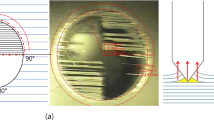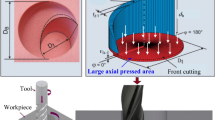Abstract
This paper focuses on finding a suitable drill bit for drilling Carbon Fiber Reinforced Plastic (CFRP). The drilling characteristics of the dagger drill, the double point angle drill, and the candle stick drill are studied. The results show that the side edge has poor ability to remove burrs, and the tip structure of the outer corner of the candle stick drill can greatly reduce the entry damage. However, the outer corner small tip structure of the candle stick drill cannot effectively remove the uncut fiber around θ = 0° of hole exit. The long secondary cutting edge of the dagger drill makes a small thrust force at the drilling exit stage and reduces the dropping speed of the thrust force, leading a lower impact on the laminate bottom. Then, a new tool is developed for drilling CFRP based on the advantages of the three kinds of drill bits. The drill has a long secondary cutting edge, a small tip diameter and a small tip structure of the outer corner. And its drilling characteristics are analyzed. The result shows that the new compound drill bit can effectively remove fibers and reduce thrust force at the drilling exit stage, form burr-free and small delamination hole. The drill reduces the waste of CFRP in manufacturing process since the exit damage is reduced substantially, which is in line with the concept of green manufacturing.




















Similar content being viewed by others
Abbreviations
- θ :
-
The angle between the cutting speed and the fiber direction
- β :
-
Helix angel
- Fd:
-
Delamination factor
References
Doh Roh, H., Lee, H., & Park, Y.-B. (2016). Structural health monitoring of carbon-material reinforced polymers using electrical resistance measurement. International Journal of Precision Engineering and Manufacturing-Green Technology, 3(3), 311–3216.
Kumaran, S. T., Ko, T. J., & Kurniawan, R. (2018). Grey fuzzy optimization of ultrasonic-assisted EDM process parameters for deburring CFRP composites. Measurement, 123, 203–212.
Mishra, R., Malik, J., Singh, I., & Davim, J. P. (2010). Neural network approach for estimate the residual tensile strength after drilling in uni-directional glass fiber reinforced plastic laminates. Materials and Design, 31(6), 2790–2795.
Zitoune, R., Krishnaraj, V., Sofiane, A. B., Collombet, F., Sima, M., & Jolin, A. (2012). Influence of machining parameters and new nanocoated tool on drilling performance of CFRP/aluminium sandwich. Composites Part B Engineering, 43(3), 1480–1488.
Islam, M. M., Li, C. P., & Ko, T. J. (2017). Dry electrical discharge machining for deburring drilled holes in CFRP composite. International Journal of Precision Engineering and Manufacturing-Green Technology, 4(2), 149–1541.
Knashaba, U. A. (2013). Drilling of polymer matrix composites: A review. Journal of Composite Materials, 47(15), 1817–1832.
Kumaran, S. T., Ko, T. J., Li, C. P., Yu, Z., & Uthayakumar, M. (2017). Rotary ultrasonic machining of woven CFRP composite in a cryogenic environment. Journal of Alloys and Compounds, 698, 984–993.
Rubio, J. C., Abrao, A. M., Faria, P. E., Correia, A. E., & Davim, J. P. (2008). Effects of high speed in the drilling of glass fiber reinforced plastic: Evaluation of the delamination factor. International Journal of Machine Tools and Manufacture, 48, 715–720.
Tsao, C. C., & Hocheng, H. (2007). Parametric study on thrust force of core drill. Journal of Materials Processing Technology, 192–193, 37–40.
Xu, J. Y., An, Q. L., Cai, X. J., & Chen, M. (2013). Drilling machinability evaluation on new developed high-strength T800S/250F CFRP laminates. International Journal of Precision Engineering and Manufacturing, 14, 1687–1696.
El-Sonbaty, I., Khashaba, U. A., & Machaly, T. (2004). Factors affecting the machine-ability of GFR/epoxy composites. Composite Structures, 63(3-4), 329–338.
Chen, W. C. (1997). Some experimental investigation in the drilling of carbon fiber-reinforced plastics (CFRP) composite laminates. International Journal of Machine Tools and Manufacture, 37, 1097–1108.
Fernandesa, M., & Cook, C. (2006). Drilling of carbon composites using a one shot drill bit. Part I: Five stage representation of drilling and factors affecting maximum force and torque. International Journal of Machine Tools and Manufacture, 46(1), 70–75.
Shyha, I. S., Aspinwall, D. K., Soo, S. L., & Bradley, S. (2009). Drill geometry and operating effects when cutting small diameter holes in CFRP. International Journal of Machine Tools and Manufacture, 49(12–13), 1008–1014.
Jia, Z. Y., Fu, R., Niu, B., Qian, B. W., Bai, Y., & Wang, F. J. (2016). Novel drill structure for damage reduction in drilling CFRP composites. International Journal of Machine Tools and Manufacture, 110, 55–65.
Abrão, A. M., Faria, P. E., Rubio, J. C. C., Reis, P., & Davim, J. P. (2007). Drilling of fiber reinforced plastics: a review. Journal of Materials Processing Technology, 186(1-3), 1–7.
Su, F., Wang, Z., Yuan, J., & Cheng, Y. (2015). Study of thrust forces and delamination in drilling carbon-reinforced plastics (CFRPs) using a tapered drill-reamer. The International Journal of Advanced Manufacturing Technology, 80(5-8), 1457–1469.
DiPaolo, G., Kapoor, S. G., & DeVor, R. E. (1996). An experimental investigation of the crack growth phenomenon for drilling of fiber-reinforced composite materials. Journal of Engineering for Industry, 118(1), 104–110.
Tsao, C. C., & Hocheng, H. (2005). Effects of exit back-up on delamination in drilling composite materials using a saw drill and a core drill. International Journal of Machine Tools and Manufacture, 45(11), 1261–1270.
Qi, Z., Zhang, K., Li, Y., Liu, S., & Cheng, H. (2014). Critical thrust force predicting modeling for delamination-free drilling of metal-FRP stacks. Composite Structures, 107(1), 604–609.
Phadnis, V., Makhdum, F., Roy, A., & Silberschmidt, V. (2013). Drilling in carbon/epoxy composites: experimental investigations and finite element implementation. Composites: Part A, 47, 41–51.
Islam, M. M., Li, C. P., Won, S. J., & Ko, T. J. (2017). A deburring strategy in drilled hole of CFRP composites using EDM process. Journal of Alloys and Compounds, 703, 477–485.
Acknowledgement
The work is supported by the National Natural Science Foundation of China (Nos. 51775184, 51275168 and 51605161).
Author information
Authors and Affiliations
Corresponding author
Additional information
Publisher's Note
Springer Nature remains neutral with regard to jurisdictional claims in published maps and institutional affiliations.
Rights and permissions
About this article
Cite this article
Qiu, X., Li, P., Li, C. et al. New Compound Drill Bit for Damage Reduction in Drilling CFRP. Int. J. of Precis. Eng. and Manuf.-Green Tech. 6, 75–87 (2019). https://doi.org/10.1007/s40684-019-00026-3
Received:
Revised:
Accepted:
Published:
Issue Date:
DOI: https://doi.org/10.1007/s40684-019-00026-3




